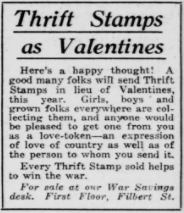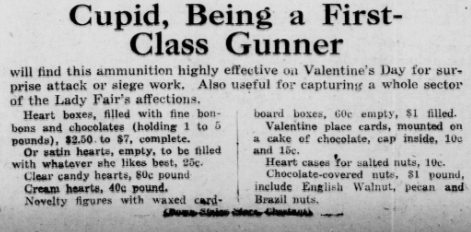Make Love AND War? Valentine's Day During the First World War

Friends, it is February, and this Wednesday many will be celebrating Valentine’s Day with their special someones. Valentine’s Day, as we celebrate it today, is a day for cherishing romantic love and showing how you feel about them, whether through a nice dinner together, a bouquet of flowers, chocolate or other candies, or any combination of these. As I realized this romantic, if seemingly consumerist, holiday was approaching I found myself wondering, how did Americans in Philadelphia celebrate Valentine’s Day 100 years ago? Was the Valentine’s Day of 1918 a different affair? Well have no fear, for I have plumbed Philadelphia’s newspapers to figure it out for you.
Searching through the Philadelphia Inquirer, I was surprised that all I found relating to Valentine’s Day in the week leading up to it were advertisements. For example, one ad asks, “Have You Bought Your Valentines?” which they could by for upwards of one cent, telling their readers that they “don’t want to leave anybody out.” Another announces the sale of clear hard Valentine’s Day candies and novelties at the Strawbridge & Clothier shop on the block of 8th, Market, and Filbert Streets in Philadelphia. Their hard candies came in red and assorted other colors, and they also sold butter cream hearts, apple butter hearts, and red Jordan almonds, assortments of which could be packaged in paper or satin heart boxes for your special one.

- In this advertisement from Wanamaker's in the Philadelphia Inquirer on Feburary 12, 1918 asks readers if they have purchased their Valentines yet, since the holiday is just two days away. Tell me, reader, do you purchase Valentines? If so, for whom?
The deeper I looked, however, the more I realized that some of these ads were not just to sell their Valentine’s Day themed goodies – they were also marketed as supporting the war effort. For example, another ad from Strawbridge & Clothier suggests that you buy stamps instead of Valentines for your beloved. “Girls, boys, and grown folks everywhere are collecting them, and anyone would be pleased to get one from you as a love-token – an expression of love of country as well as of the person to whom you send it.” My personal favorite, from Wanamaker’s, announces the sale of various candies for the holiday – all of which can, of course, be packaged in paper or satin heart boxes – refers to Cupid as a “First-Class Gunner.”


- Each of these advertisements comes from the Philadelphia Inquirer in 1918, the one above from February 12 and the one below from February 8. Each of these advertisements provides an example of how World War I was constantly imprinted onto the minds of Americans, and how support for the war effort became part of all aspects of life, even the celebration of holidays like Valentine's Day.
What on Earth are we to make of this fascinating conflation of love and war? The replacement of Valentines with stamps to fund the war effort makes sense contextually amid the rationing and sales of Liberty Loans, but what of this portrayal of Cupid, a deity of love who uses his arrows to help the loveless find someone, as a military man who will fell the Huns and treat candies as ammunition in his quest for love. The ad reads, “Cupid, being a first-class gunner, will find this ammunition highly effective on Valentine’s Day for surprise attack or siege work. Also useful for capturing a whole sector of the Lady Fair’s affections.”
This conflation of general consciousness of the war abroad and Valentine's Day romance is not altogether surprising, but fascinates me. It makes me wonder, during other periods of conflict in American history would we find similar advertisements as these - where declarations and acts of love are conflated with military conquests?
I would love to hear your thoughts, dear reader. What are your plans this Valentine’s Day? How would you respond to advertisements like this on the radio, television, or internet if you saw them?
100% of the SBD rewards from this #explore1918 post will support the Philadelphia History initiative @phillyhistory. This crypto-experiment is part of a graduate course at Temple University's Center for Public History and is exploring history and empowering education to endow meaning. To learn more click here.
Sources:
“Have You Bought Your Valentines?” Philadelphia Inquirer, February 12, 2018.
“St. Valentine’s Day Candies and Novelties,” Philadelphia Inquirer, February 7, 1918.
“Thrift Stamps as Valentines,” Philadelphia Inquirer, February 12, 1918.
“Cupid, Being a First-Class Gunner,” Philadelphia Inquirer, February 8, 1918.
Interesting. Not sure how much a role romantic love plays in war (although the Sacred Band of Thebes would be an interesting study for that), but brotherly love definitely plays a big part. Probably the number 1 motivation I've heard for most soldiers for staying in adverse situations, not quitting, and continuing to fight is to protect fellow soldiers.
Cupid does appear to be an expert marksman. He never seems to miss, and always hits his targets directly in their hearts.
Thanks so much for your input! Maybe an interesting follow-up post could be looking to see if that concept of brotherly love was better incorporated into the consciousness of World War I at home, especially here in Philadelphia of all places. Perhaps around the Fourth of July we would see something like that. What do you think?
That would be an interesting post, especially to see how that concept was expressed by soldiers and then if/how it made its way into the popular consciousness.
Another war; another valentine. The Library Company's comic valentines from the mid-19th century may have no equal.
Many more online here.